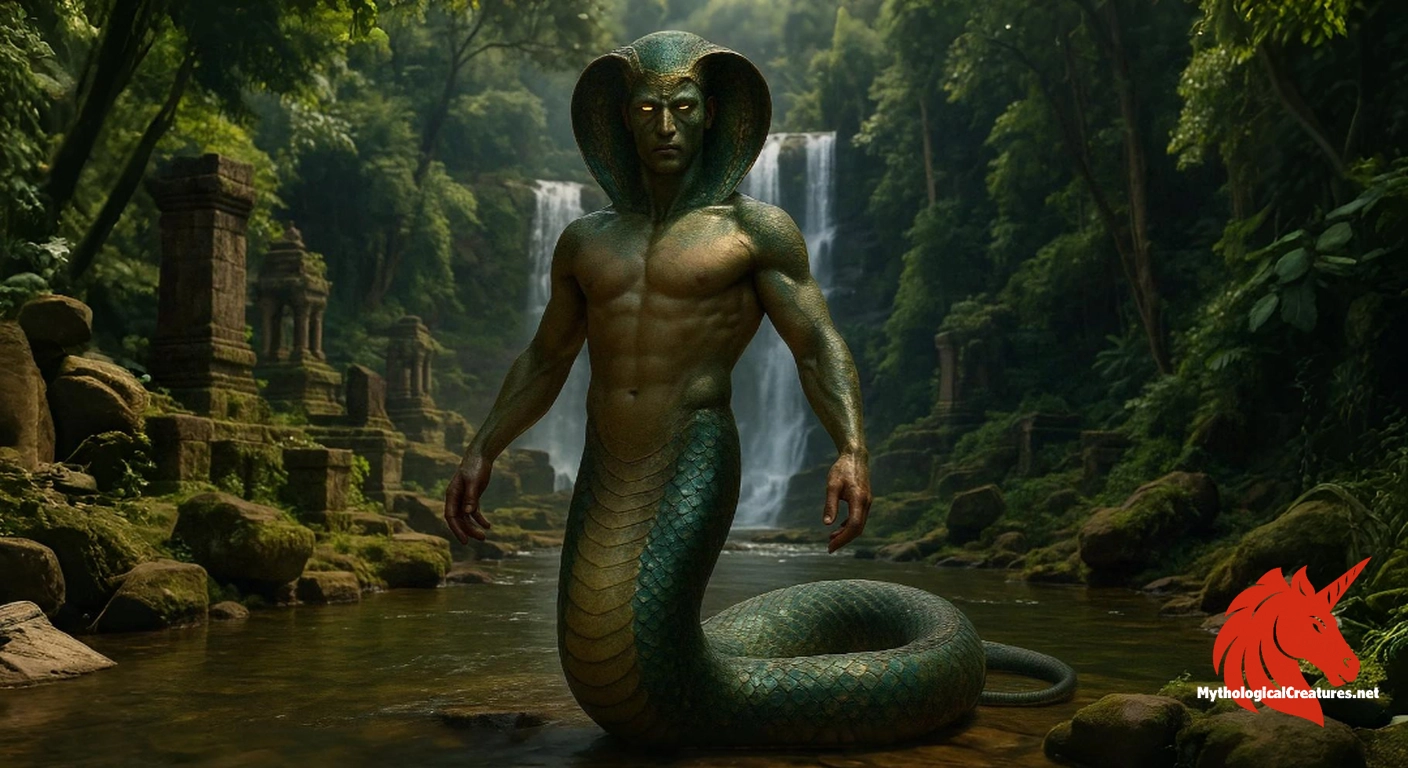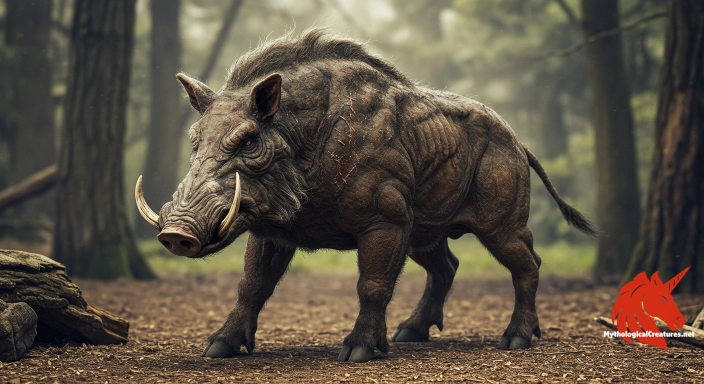Nāga: Nāgas are divine, semi-divine beings from Asian mythology, depicted as half-human, half-cobra entities.

Nāga
Nāga - Nāgas hold deep cultural and religious significance across South and Southeast Asia, symbolising fertility, protection, and the mysterious power of nature.
Origins & First Encounters
Nāga are enigmatic beings whose mystique has captivated cultures across Asia for millennia. Born from rich mythological traditions, their origin is traced to divine unions, most notably as the progeny of the sage Kashyapa and Kadru. These serpentine deities have been revered since ancient times, with early attestations found in scriptures that emphasise their semi-divine nature. They are often portrayed as hybrids, merging human attributes with the graceful potency of the cobra. In many accounts, they inhabit the mysterious netherworld known as Patala, which further underlines their liminal status between the mortal realm and the divine. With rituals and iconography dedicated to them for over 2,000 years, Nāga have been integral to both religious ceremonies and artistic expressions. Their representation as water spirits and guardians of treasures signifies their broader role in symbolising fertility, protection, and cosmic order. Temples, sculptures, and folklore across South and Southeast Asia bear witness to their enduring cultural relevance.
Source Texts & Tale Variants
Ancient texts and oral narratives offer a vivid tapestry of stories concerning Nāga. They appear prominently in early Sanskrit literature, where various Puranas and epic narratives such as the Mahabharata incorporate their mythic exploits. Buddhist scriptures, including Jataka tales and other canonical documents, also integrate stories of these serpentine entities, often highlighting their metamorphic abilities. Regional folklore further enriches their legend, with distinct ritual practices and temple traditions preserving local variants of their story. Carvings and murals found in ancient monuments add another layer, revealing how artistic depictions have immortalised their image over centuries. Many of these sources describe Nāga as both benevolent protectors and mysterious creatures with formidable power. The convergence of scriptural texts and oral tradition has led to a multiplicity of tales that, while varying in detail, consistently underline their sacred status. Over time, as regional narratives evolved, the portrayal of Nāga diversified, reflecting the unique cultural contexts in which these beings were revered.
Form & Powers
Iconography of Nāga presents a striking blend of human and serpentine features that has captivated artists and devotees alike. Many depictions reveal a majestic upper body reminiscent of humankind, seamlessly transitioning into the sinuous form of a snake below. Their scales, often rendered in shimmering hues of emerald, gold, or deep green, accentuate their divine and otherworldly allure. In several traditions, they are shown with elaborate snake hoods draped over their heads, evoking the grace of cobras in a stance of both alertness and repose. Some representations even emphasise an almost hypnotic quality in their eyes, which are painted with meticulous detail to evoke mystery and wisdom. The physicality of Nāga is further enhanced by ornate jewellery and tribal markings, symbolising their noble lineage. Artistic renditions sometimes vary in size, from imposing guardians of subterranean realms to more human-scale figures interwoven with nature. This careful balance between human traits and reptilian characteristics highlights both their mortal connections and their exalted, mythical origins. Their duality not only reinforces their mystical role but also serves as a metaphor for the merging of earth and spirit.
Regional Faces
The figure of Nāga adapts gracefully to the cultural and geographic contours of different regions. In the Indian subcontinent, they are primarily celebrated as water deities whose imagery is interwoven with temple architecture and sacred rites. In contrast, Southeast Asian traditions, such as those in Thailand, Cambodia, and Laos, often depict Nāga in a more dragon-like manner, adorned with elaborate and colourful ornamental features. Local folklore has embraced these entities as harbingers of both good fortune and natural abundance, frequently associating them with the cyclical forces of rainfall and fertility. Sri Lankan myth, for instance, imbues Nāga with roles that resonate with indigenous beliefs about protection and agricultural prosperity. Each regional narrative tailors the physical attributes and symbolic importance of Nāga to align with local religious practices and environmental conditions. From ritual dances to vibrant murals, the diverse portrayals of Nāga reflect a harmonious blend of historic belief and artistic innovation. These regional variations underline the adaptability of their symbolism, as each community finds in them a mirror for their own cultural and environmental concerns.
Cultural Parallels
The myth of Nāga shares intriguing parallels with dramatised serpent phenomena found in various parts of the world. In Chinese tradition, dragons embody similar themes of water control and imperial power, presenting a close cultural kinship to the Nāga. European legends, too, recount serpent-like creatures that vigilantly guard treasures and possess an aura of both menace and protection. The Mesoamerican deity Quetzalcoatl, often depicted as a feathered serpent, further emphasises the universal appeal of the serpentine form in symbolising life and cosmic order. Polynesian myths include water spirits with elongated, sinuous forms that echo the Nāga’s aquatic and regenerative symbolism. These cross-cultural connections underscore a shared human fascination with the snake as a potent emblem of duality—both nurturing and dangerous. Despite variations in appearance and narrative, the core attribute of transformation and renewal remains central. The comparative study of these figures reveals a global tapestry of myth, in which the Nāga occupies a unique yet familiarly resonant position among the divine creatures of folklore.
Legacy & Modern Evolution
The evolution of Nāga from ancient lore to contemporary cultural iconography is a testament to their enduring appeal. Historically revered as divine guardians and mystical protectors, their image has seamlessly transitioned into modern narratives through art, literature, and film. Contemporary interpretations often cast them as enigmatic antiheroes or benevolent guardians who straddle the realms of tradition and modernity. The ritual festivals and temple ceremonies that celebrate Nāga continue to inspire a sense of reverence in both rural sanctuaries and urban cultural festivals. Modern artistic endeavours, from graphic novels to digital media, have embraced and reimagined their serpentine elegance, highlighting themes of transformation and environmental consciousness. In this process, Nāga have come to symbolise not only ancient wisdom but also a dynamic dialogue between the past and the present. Their layered symbolism—encompassing fertility, protection, and the mysteries of nature—resonates deeply with contemporary audiences. The rich legacy of Nāga reinforces their position as living symbols that adapt and thrive across cultural and temporal boundaries, ensuring their myth continues to inspire and captivate future generations.
Interesting Fact
A striking aspect of Nāga mythology is that many diverse communities, from the Nagavanshi to the Khmer and Eelamese, proudly claim descent from these mystical serpent beings, highlighting their widespread cultural impact.
Quick Creature Info
Type:
Associations:
Our Mythic Legendary Rating:

Also Sometimes Known As:
Habitat:
Supernatural Powers:
Physical Attributes:
Abilities:
Behavior:
Lore:
Related Creatures, Tales or Lore
- QQuetzalcoatl
- JJörmungandr
- KKaliya
References
Discover Another Mythical Legend You May Not Have Heard Of?
Uncover the mysteries of ancient folklore and expand your knowledge of legendary beings from cultures around the world.
Dare to Meet the Erymanthian boar....
Mythical Disclaimer: The images and data on this site are derived from various historical and literary sources, but we have found that many myths often have multiple versions and interpretations across references, sometimes contradictory. As a result, these creature depictions are artistic interpretations—imaginative blends of folklore, legend, and a dash of AI guesswork. Because creature descriptions vary widely, our illustrations and accompanying information represent our best effort to honor mythology while bridging creative gaps. Enjoy these interpretations—just remember, we've done our best to respect the stories and validate available data, but in the realm of mythology, details often shift, imagination leads the way, and nothing is ever set in stone!
Curated by the Mythological Creatures Team (rev. May 2025)
